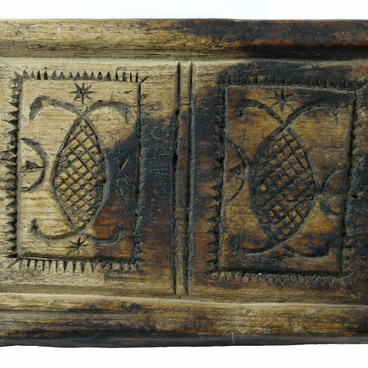In 1960, the Orlov Museum of Regional Studies received items that belonged to the Lutov burgher family. Among them was a wedding dress, presented in the exposition. Maria Lutovaya wore the wedding dress in 1890.
The dress consists of a blouse, a pelerine and a skirt. It is sewed of white wool and trimmed with gas, a light transparent material. The same material is used to make a bow, sewn on the skirt. The sleeves are widened on the top and gathered at the shoulder in pleats. The dress is decorated with pin tucks on the sleeves and pelerine and with thin ruffles made of gas.
In the nineties of the 19th century, women’s fashion was changing rapidly. Women began to work in businesses, actively engaged in art, science, and politics. Therefore, women’s clothing also became more strict and businesslike. The so-called English suit became popular. It consisted of a straight skirt and a lined jacket with a collar and lapels.
In the late 19th century, classic dress consisted of a tight bodice and skirt, gathered at the waist and flowing freely over the hips. The stand-up collar was a traditional detail in clothes of that time: it was used as a decoration for coats, dresses, and blouses of thin fabrics.
Ball gowns were made of light materials, mostly in warm colors. Ornaments were not factory-stitched and sewed on the fabric by hand. Everyday dresses were made of linen, pique, cotton, cashmere, and other inexpensive fabrics.
At the end of the 19th century, dresses no longer used crinoline, a stiff skirt frame that gave volume to the skirt. They also abandoned the tournure — a small pillow, which was placed under the dress at the back below the waist to give a puffed figure. But corsets remained and even became heavier since an hourglass shape came in vogue.
Wedding dresses in Russia for a long time were not white, because this color was considered the color of holiness. Girls wore white dresses to a nunnery, not to the wedding. In ancient Russia, they married in red. The sarafan for such events was decorated with embroidery, pearls, beads, golden threads, fur, and sometimes even with precious stones. The bride embroidered the dress by herself. So she demonstrated her skills to her future husband. At the beginning of the 18th century, Peter the Great issued a decree according to which everyone had to follow the European fashion. This is how the first wedding dresses in Russia were white, but in the villages, girls for a very long time continued to wear the usual red. After the revolution of 1917 church weddings were canceled, registry offices appeared, and the wedding fashion was forgotten for a few decades. As a rule, newlyweds came to register their relations in casual clothes. The fashion for wedding dresses began to return only in the 1960s.
The dress consists of a blouse, a pelerine and a skirt. It is sewed of white wool and trimmed with gas, a light transparent material. The same material is used to make a bow, sewn on the skirt. The sleeves are widened on the top and gathered at the shoulder in pleats. The dress is decorated with pin tucks on the sleeves and pelerine and with thin ruffles made of gas.
In the nineties of the 19th century, women’s fashion was changing rapidly. Women began to work in businesses, actively engaged in art, science, and politics. Therefore, women’s clothing also became more strict and businesslike. The so-called English suit became popular. It consisted of a straight skirt and a lined jacket with a collar and lapels.
In the late 19th century, classic dress consisted of a tight bodice and skirt, gathered at the waist and flowing freely over the hips. The stand-up collar was a traditional detail in clothes of that time: it was used as a decoration for coats, dresses, and blouses of thin fabrics.
Ball gowns were made of light materials, mostly in warm colors. Ornaments were not factory-stitched and sewed on the fabric by hand. Everyday dresses were made of linen, pique, cotton, cashmere, and other inexpensive fabrics.
At the end of the 19th century, dresses no longer used crinoline, a stiff skirt frame that gave volume to the skirt. They also abandoned the tournure — a small pillow, which was placed under the dress at the back below the waist to give a puffed figure. But corsets remained and even became heavier since an hourglass shape came in vogue.
Wedding dresses in Russia for a long time were not white, because this color was considered the color of holiness. Girls wore white dresses to a nunnery, not to the wedding. In ancient Russia, they married in red. The sarafan for such events was decorated with embroidery, pearls, beads, golden threads, fur, and sometimes even with precious stones. The bride embroidered the dress by herself. So she demonstrated her skills to her future husband. At the beginning of the 18th century, Peter the Great issued a decree according to which everyone had to follow the European fashion. This is how the first wedding dresses in Russia were white, but in the villages, girls for a very long time continued to wear the usual red. After the revolution of 1917 church weddings were canceled, registry offices appeared, and the wedding fashion was forgotten for a few decades. As a rule, newlyweds came to register their relations in casual clothes. The fashion for wedding dresses began to return only in the 1960s.



